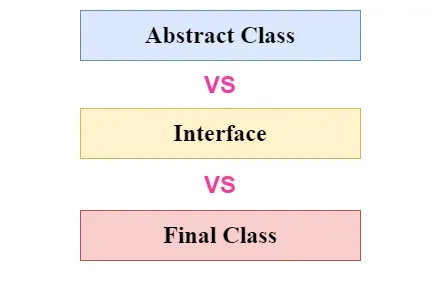In the dynamic realm of programming, the choice between abstract classes, interfaces, and final classes can significantly impact the design and functionality of your software. Understanding the differences between these constructs is crucial for developers aiming to craft efficient, maintainable, and extensible code. In this comprehensive guide, we delve into the intricacies of abstract classes, interfaces, and final classes, shedding light on their distinct characteristics and use cases.
Abstract Classes: The Foundation of Abstraction
Abstract classes stand as a cornerstone in object-oriented programming, providing a blueprint for other classes. Although they are not self-instantiable, they form the basis for derived classes. An abstract class may contain both regular methods and abstract methods, which act as placeholders that concrete subclasses must implement.
The primary advantage of abstract classes lies in their ability to enforce a common structure across multiple classes, promoting code reusability and maintaining a clear hierarchy. Developers often opt for abstract classes when there is a need for a shared base class with some common functionality among its subclasses.
Interfaces: The Blueprint for Contracts
In the quest for code flexibility and multiple inheritances, interfaces emerge as a powerful tool. An interface defines a contract that implementing classes must adhere to, ensuring a standardized set of methods. Unlike abstract classes, interfaces cannot contain method implementations, only method signatures.
Interfaces facilitate loose coupling between components, enabling a class to implement multiple interfaces. This flexibility proves invaluable when dealing with diverse functionalities across different classes. Developers often leverage interfaces to create a common ground for unrelated classes to share specific behaviors.
Final Classes: The Culmination of Restriction
Contrary to abstract classes and interfaces, a final class serves as the endpoint of class inheritance. A class cannot be extended by another class once it is declared final. This restriction ensures the integrity of the final class's design, preventing unintended modifications or extensions.
Final classes find their niche in situations where a certain class should not be altered or extended further. They provide a level of security and stability to critical components within a codebase. Developers often choose final classes when aiming to create a robust, unmodifiable foundation for a particular functionality.
Choosing Wisely: When to Opt for Each
Abstract Classes in Action
When you envision a shared structure among related classes and anticipate the need for both concrete and abstract methods, an abstract class proves indispensable. It forms the backbone of a hierarchical relationship, fostering code consistency and facilitating future expansions.
Harnessing the Power of Interfaces
For scenarios demanding flexibility, where a class needs to adhere to multiple contracts, interfaces become the weapon of choice. Implementing interfaces allows classes to define their unique behaviors while obliging them to conform to specific method signatures.
Final Classes: The Fortress of Code
When your design calls for a sealed, unmodifiable class that withstands any form of extension, the final class stands as the guardian. It ensures the preservation of your code's integrity, making it an ideal choice for components that should remain untouched and unextended.
Key Differences: Abstract Class vs. Interface vs. Final Class
| Aspect | Abstract Class | Interface | Final Class |
|---|---|---|---|
| Instantiation | Cannot be instantiated on its own | Cannot be instantiated on its own | Can be instantiated |
| Methods | Can have both regular and abstract methods | Contains only method signatures | May have concrete methods |
| Extension | Can be extended by other classes | Implemented by classes, facilitating multiple inheritances | Cannot be extended |
| Use Cases | Provides a common structure for related classes | Defines a contract for implementing classes | Ensures the class cannot be further extended |
| Flexibility | Moderate flexibility due to both abstract and concrete methods | High flexibility, allowing multiple interfaces to be implemented | Low flexibility as it cannot be extended |
| Keyword | abstract class | interface | final class |
FAQs:
Q1. Can a class be both abstract and final?
Answer: No, a class cannot be both abstract and final. An abstract class is meant to be extended by other classes, while a final class is designed to prevent extension. These concepts are mutually exclusive.
Q2. Are interfaces only used for multiple inheritances?
Answer: While interfaces facilitate multiple inheritances, their primary purpose is to define a contract that implementing classes must adhere to. They provide a standardized way for unrelated classes to share specific behaviors.
Q3. What happens if I try to instantiate an abstract class?
Answer: Attempting to instantiate an abstract class directly will result in a compilation error. Abstract classes are meant to be subclassed, and instances are created from the concrete subclasses.
Q4. Can I declare an interface as final?
Answer: No, interfaces cannot be declared as final. The 'final' keyword is applicable to classes, preventing them from being extended. Interfaces, being a contract, are meant to be implemented by multiple classes.
Q5. How does a final class contribute to code security?
Answer: A final class ensures code security by preventing further extension. This restriction safeguards the integrity of the class's design, reducing the risk of unintended modifications and enhancing code stability.
Q6. When should I prefer interfaces over abstract classes?
Answer: If your design requires flexibility and a class needs to adhere to multiple contracts, interfaces are preferable. They allow for diverse functionalities across different classes while maintaining a standardized set of methods.
Conclusion:
In the ever-evolving landscape of software development, understanding the nuanced differences between abstract classes, interfaces, and final classes is paramount. Each construct plays a distinctive role in shaping the architecture and behavior of your codebase. Selecting the best strategy will rely on the particular needs and goals of your project.

Post a Comment